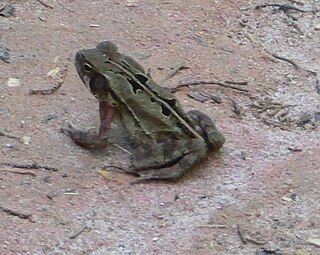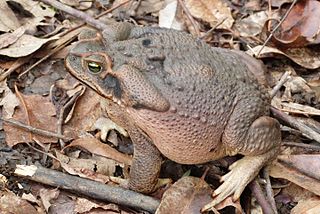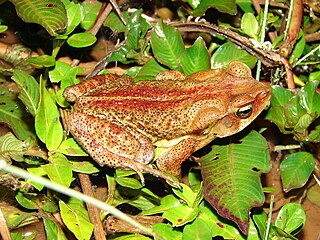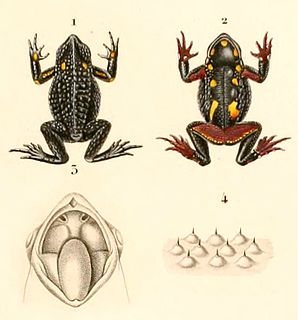Rhinella chavin is a species of toads from family Bufonidae. It is endemic to the Huánuco Region, Peru. It lives in cloud forests of eastern Andean slopes at altitudes of 2,600–3,072 metres (8,530–10,079 ft). It is listed as an endangered species due to a restricted range and threats from habitat loss and water pollution.

Rhinella achalensis is a species of toad in the family Bufonidae that is endemic to northern Argentina.
Rhinella acutirostris is a species of toad in the family Bufonidae. It is found in Brazil, Colombia, Panama, and Venezuela. Its natural habitats are subtropical or tropical moist lowland forests, freshwater marshes, and intermittent freshwater marshes.
Rhinella amboroensis is a species of toad in the family Bufonidae that is endemic to the region of its type locality in the Carrasco Province of Bolivia and the adjacent Santa Cruz Department. Its common name is Cochabamba toad. It may exist in the Carrasco National Park and/or Amboró National Park, depending on its exact range.
Rhinella arborescandens is a species of toad in the family Bufonidae. It is endemic to Peru and only known from its type locality near Mendoza, northern Cordillera Central, in the Amazonas Region. It is unusual among Rhinella toads because it is arboreal, hence the specific name arborescandens, derived from Latin arbor for tree and scando meaning to climb.

Rhinella arunco is a species of toad in the family Bufonidae that is endemic to Chile. Its natural habitats are subtropical or tropical dry shrubland, rivers, intermittent rivers, freshwater marshes, intermittent freshwater marshes, water storage areas, ponds, aquaculture ponds, open excavations, and irrigated land. It is threatened by habitat loss.

Rhinella crucifer is a species of toad in the family Bufonidae. It endemic to Brazil and known from the Atlantic Forest of eastern Brazil between the states of Ceará in the north and Rio de Janeiro in the south. Common name striped toad has been coined for it. "Rhinella pombali" is a hybrid between Rhinella ornata and this species.

Rhinella diptycha, sometimes referred to as Cope's toad, Schneider's toad, cururu toad, or rococo toad, is a toad found in northern Argentina, Paraguay, Uruguay, eastern Bolivia, and eastern and southern Brazil. It is one of three rather similar species sometimes referred to as "cururu toads" in Brazil, the others being R. jimi and R. marina. Like those, R. diptycha is a large toad, females up to 25 cm (9.8 in) in snout–to–vent length and males up to 18 cm (7.1 in).
Rhinella fissipes, the Carabaya toad, is a species of toad in the family Bufonidae that is found in Bolivia and Peru. Its natural habitats are subtropical or tropical moist montane forests, rivers, freshwater marshes, and intermittent freshwater marshes.

Rhinella granulosa, also known as granular toad and common lesser toad, is a species of toad in the family Bufonidae. The species was redelimited in 2009 and is now considered endemic to Brazil.
Rhinella justinianoi is a species of toad in the family Bufonidae that is endemic to Bolivia. Its natural habitats are subtropical or tropical moist montane forests and rivers. It is threatened by habitat loss.
Rhinella nesiotes is a species of toad in the family Bufonidae that is endemic to Peru. Its natural habitats are subtropical or tropical moist lowland forests and subtropical or tropical moist montane forests. It is threatened by habitat loss.

Rhinella ornata is a species of toad in the family Bufonidae that is found in Brazil and possibly Argentina. Its natural habitats are subtropical or tropical moist lowland forests, rivers, and intermittent freshwater lakes. It is threatened by habitat loss.
Rhinella rubropunctata is a species of toad in the family Bufonidae that is found in southern Chile and Argentina. Its natural habitats are humid to xeric temperate forests and open environments. It tolerates a certain degree of disturbance. Breeding takes place in shallow temporary ponds near rivers, reservoirs and lakes. It is threatened by habitat degradation and fragmentation.
Rhinella rumbolli is a species of toad in the family Bufonidae that is found in Argentina and possibly Bolivia. Its natural habitats are temperate forests and rivers. It is threatened by habitat loss.

Rhinella spinulosa is a species of toad in the family Bufonidae that is found in the Andean Argentina, Bolivia, Chile, and Peru.
Rhinella vellardi, the Alto Marañon toad, is a species of toad in the family Bufonidae that is endemic to Peru. It is only known from the type locality in the upper Marañón area, Cajamarca Region of northern Peru. Its natural habitat is montane forest in the upper Amazon basin. It is a rare species of which little is known.
Rhinella veraguensis is a species of toad in the family Bufonidae. It is found in the Amazonian versant of the Andes and in the inter-Andean valleys in Bolivia and southeastern Peru. Its natural habitats are montane tropical forests and cloud forests. Breeding takes place in streams. There are no major threats to this common species, although it can locally suffer from habitat loss.

Rhinella festae is a species of toad in the family Bufonidae. It is found in Ecuador and Peru. Its natural habitats are subtropical or tropical moist lowland forests and subtropical or tropical moist montane forests. It is threatened by habitat loss.

Rhinella achavali is a species of toads in the family Bufonidae that is found in Uruguay and southernmost Brazil.









